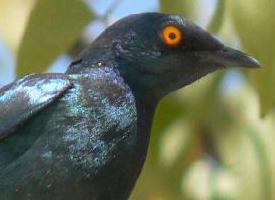
Váhy a míry
| Délka | od 19 do 22 cm |
|---|---|
| Hmotnost | od 60 do 90 g |
| Délka rozpětí křídel | od 37 do 42 cm |
Stav ohrožení
| Ohrožen |
Popis zvířete
The Common Starling (Sturnus vulgaris), often simply referred to as the starling, is a medium-sized passerine bird in the starling family, Sturnidae. It is about 20 cm (7.9 in) in length and has a wingspan ranging from 31 to 44 cm (12 to 17 in). The bird is characterized by its dark plumage with a metallic sheen, which, upon closer inspection, reveals a spectacular array of colors from purples to greens depending on the light. Juveniles are duller in appearance, sporting a grey-brown coloration until they molt into their adult plumage.One of the most distinctive features of the Common Starling is its vocalization. It is a highly social and vocal bird known for its wide range of sounds, including whistles, clicks, and even mimicry of other birds and environmental noises. Starlings are capable of imitating a variety of sounds from their surroundings, which can include car alarms and human speech patterns, showcasing their impressive adaptability.
Native to most of Europe and western Asia, the Common Starling has been introduced to numerous other regions including Australia, New Zealand, and North America, where it has successfully adapted and in many cases, become an invasive species. This adaptability is a testament to the bird's generalist diet and nesting habits. Starlings are omnivorous, feeding on a wide range of invertebrates, fruits, and seeds. They are particularly noted for their ability to extract soil invertebrates, such as earthworms and larvae, using their strong, pointed beaks in a unique foraging behavior known as "probing."
Starlings are cavity nesters, utilizing natural holes in trees or cliffs, as well as man-made structures, to lay their eggs. Their nests are made from a variety of materials, including twigs, grasses, and leaves, and are often lined with softer materials for the eggs. The female typically lays between 4 and 6 eggs, which she incubates for about 12 days until they hatch. Both parents are involved in feeding the chicks, which fledge approximately 21 days after hatching.
The breeding season sees the transformation of the Common Starling into a highly social creature, forming large flocks that can number in the thousands. These flocks create spectacular aerial displays known as murmurations, where the birds move in tight, coordinated patterns that can appear as undulating waves, tight clusters, or expanding and contracting shapes. Murmurations are thought to be a defense mechanism against predators, as well as a way for starlings to share information about feeding areas.
Despite their beauty and the fascination they inspire, Common Starlings are often considered pests. Their large flocks can cause significant agricultural damage, consuming crops and competing with native species for nesting sites. Their adaptability and prolific breeding habits have allowed their populations to grow in areas where they have been introduced, leading to various control measures being implemented in an attempt to manage their impact.
In conclusion, the Common Starling is a bird of paradoxes—admired for its beauty and the mesmerizing murmurations it creates, yet vilified for its impact on ecosystems where it is considered an invasive species. Its adaptability and resilience make it a subject of interest and study among ornithologists and bird enthusiasts alike.
Mapa výskytu

Podobná zvířata
Nové fotografie zvířat
Top 10 zvířat
- Dolphin gull (Leucophaeus scoresbii)
- Diana monkey (Cercopithecus diana)
- Moustached guenon (Cercopithecus cephus)
- Galápagos tortoise (Geochelone nigra complex)
- Stone loach (Barbatula barbatula)
- Japanese macaque (Macaca fuscata)
- Russian tortoise (Testudo horsfieldii)
- Greek tortoise (Testudo graeca)
- Common flying dragon (Draco volans)
- Vendace (Coregonus albula)


